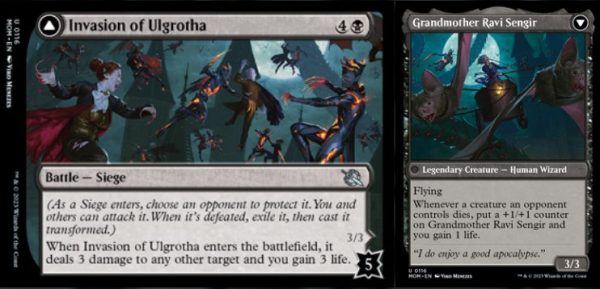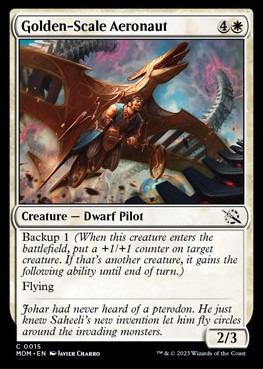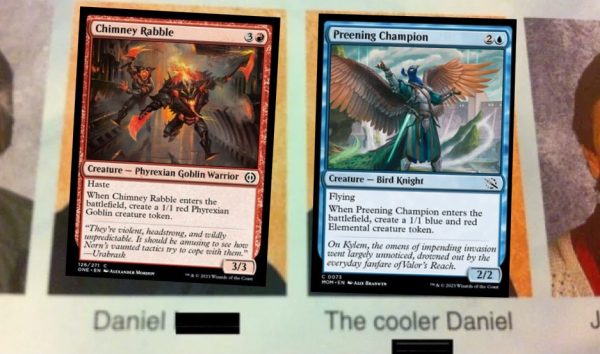Are you a Quiet Speculation member?
If not, now is a perfect time to join up! Our powerful tools, breaking-news analysis, and exclusive Discord channel will make sure you stay up to date and ahead of the curve.
The sun sets and rises again. So it is for Limited formats. March of the Machine (MOM) arrives this weekend, and with it new cards, keywords, and most intriguing of all, a new card type. Battles are the ninth card type in Magic, and the first addition to the roster since planeswalkers were introduced in Lorwyn. That was in 2007. For those keeping score at home, it's been sixteen years since a new card type debuted, so let's get right to it.
Battles and the Other Keywords
Battles are a new double-faced permanent. They can be attacked, similar to planeswalkers. Unlike planeswalkers, however, the player casting the battle chooses an opponent to defend them. They provide the caster a bonus when they enter the battlefield, and if we're able to deal them enough damage to "defeat" the battle (note: not destroy), then it flips and we get a second effect from them, usually a creature.

For example, Invasion of Ulgrotha // Grandmother Ravi Sengir offers a five-mana Lightning Helix at sorcery speed. Each damage we deal it removes a defense counter. If we remove all five, the card flips, unlocking Invasion of Ulgrotha // Grandmother Ravi Sengir. Opponents can try to protect it via blocks or otherwise. They also can destroy it with cards like Atraxa's Fall.
Though none are as novel as battles, other keywords will lay their fingerprints on the format as well. Backup gives creatures some modality as they enter the battlefield. They can enter with a +1/+1 counter, or they can give that counter to another creature. If they do, that creature inherits all subsequent abilities until end of turn.

Golden-Scale Aeronaut can be a 3/4 flyer, or a 2/3 flyer that gives another creature a +1/+1 counter and flying until end of turn.
Additionally, convoke returns, allowing creatures to tap and pay for spells bearing that keyword. Incubate is an ability that creates a token in waiting. A creature with Incubate X creates an Incubator Token, a dormant artifact, with X +1/+1 counters on it. For two mana, the token awakens into a 0/0 Phyrexian who still bears those counters. Remember: the Phyrexian token will not have summoning sickness if the Incubator was in play at the beginning of the turn.
How Keywords Shape This Format
MOM's keywords imply that this will be an aggressive format.
Backup is an ability that favors attacking. Battles generate value through the midgame. If we're ahead on board, we're able to pressure battles and unlock that battle. Pressure in MOM is different, though, then it was in ONE. Battles create detours from the opponent's life total, which will lead to longer games. Defeating a battle can help fortify those we need to defend. While early starts won't end with the swift lethality of the last format, they will create devastating advantage, which may end the game some time after. Whereas ONE was clearly an aggressive format, this one will be defined by aggression's crafty brother: tempo. Get ahead, and try to stay ahead.
Furthermore, convoke only works when we have creatures on board. Otherwise we're just overpaying for these spells. If we get on board early, we position ourselves to generate board advantage and mana efficiency. This might not be a lightning-fast format, but we still want to curve out.
Incubate tokens counter this strategy. These tokens take two mana to activate, but they're bigger than other tokens in this design space. As aggressive decks storm the midgame, trying to flip battles, these tokens will stand as massive barriers in their way.
Incubate can provide the defensive bulk needed to play a slower game. By defending our opponent's battles, we can strand card advantage and pull ahead in the late game. If we can't, we're likely to fall behind and stay there.
Can We Trust These Two-Drops?
When previewing a format, we should examine the two-drops. There are no Barbed Batterfists or Duelist of Deep Faiths to get excited over. This might be a hedge against the power of backup-driven starts. If we can get uncommon and rare two-drops, then we can play a better aggressive game. The last time I felt this way was in DMU, where the best aggressive decks wanted multiple uncommon two-drops.
The tension between challenging battles and backing up attackers against the slower midrange pace of the Phyrexian-themed spells will define this format. If we're not pressuring our opponents early, we want to stabilize as soon as possible. Using an instant-speed burn spell to flip a battle, or using the discounts on convoke cards or Ephara's Dispersal, all help with recovery. Tempo plays like these, and even timely combat tricks, will represent massive moments in individual games.
Furthermore, removal is at a premium in this format. There are plenty of bombs that will threaten to take over games, and being able to remove a key blocker to defeat a battle will help to snowball advantage. The best removal spells will help us flip our board position, and those are represented highly on our top common list.
Ranking the Top Commons
10) Overgrown Pest: This card is getting compared to Carnivorous Vorroc for all the obvious reasons, but the downgraded stats are very meaningful. ONE's best common was often the biggest creature on the board when it resolved. This card won't be. While picking up a battle will feel powerful, I'm not sure a 2/2 on three will put us in a prime spot to capitalize on it. The card should be good, but not spectacular.
9) Converter Beast: This card has a lot of stats... for admittedly a lot of work. For four mana, we get to incubate five, and the 0/1 theoretically defends our life total while we wait for the egg to hatch. The format has support for tokens and Phyrexians and even +1/+1 counters, but the card that makes me excited about this Beast is Scrollshift. It's possible that the instant is the card we need to prioritize if this hidden archetype materializes, but at least in the early weeks, we should be able to get it late.
8) Ichor Drinker: A one-drop with lifelink that dies into a 2/2? Sign me up. This card will be a nuisance in aggressive decks.
7) Cosmic Hunger: Instant-speed bite that can hit battles and planeswalkers is great. Especially because it can defeat battles at instant speed, unlocking a hidden blocker or end-step attacker. We need to make sure we have the right creature suite to support this, but it should be strong in most green decks.
6) Alabaster Host Intercessor: Six-mana commons are not frequently admitted to this list. This one has Plainscycling, so there's some inherent flexibility there. The most interesting aspect, however, is using these to facilitate a splash, where the first one not only helps cast a splash-worthy rare, but also all subsequent versions of this Samurai. It's a powerful effect, and I love the way it increases threat density as we move into the late game.
5) Ephara's Dispersal: Cheap interaction with surveil tacked on. This is a blowout against big incubate tokens, and much better on defense, where we can stabilize off of the mana-advantage this generates. In the aggressive decks, it will push damage and still be fine.
4) War Historian: The other green three-drop gets the attention. However, War Historian will challenge opponents on creature sizing, while generating value on battles and being an excellent landing place for backup counters. Pest is a good card, but this three-drop could end up the scourge of the format.
3) Deadly Derision: Killing things is good. Treasure is good. Instant-speed Grim Bounty is good.
2) Volcanic Spite: The debate between the second- and third-best commons comes down to the nature of the format. Both will thrive here. In addition to being excellent removal spells, each can help flip tempo. However, the ability to finish off a battle at instant speed to provide a flash blocker while allowing us to rummage puts the Fire Prophecy ahead by a hair.
1) Preening Champion: This card does it all. It provides evasive pressure for battles. It's a Knight for archetype synergies. It creates two bodies for convoke synergies. The token is even "blue and red" so we can pay for Stoke the Flames. The best common in the set appears to be preen-ordained.

Prerelease Weekend
This weekend marks the first chance many of us will have with the new cards. With all of the high-powered rares, battles, and even a multiverse legend in each pack, this format will be a unique experience, and one that should mature nicely. There are creative build-arounds, new mechanics, and plenty of powerful effects that should make this weekend an interesting one.
What commons did I miss? What archetypes look the strongest? How many times did you accidentally call it "March of the Machines" before being corrected? Let me know in the comments, and good luck this weekend!


















